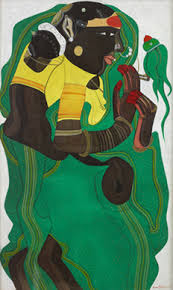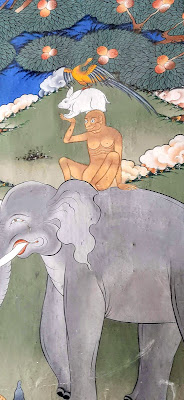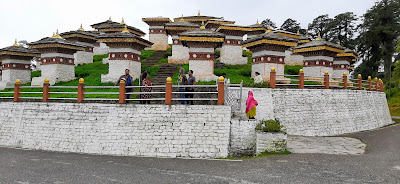TIGER’S NEST
We were driving to Paro and
from there we shall start the trek to Tiger’s Nest the next morning. It is
better to carry tablets for motion sickness because the place is 10,240 ft.
above MSL. The road is quite zig-zag. It’s a 2 – 2.5 hours trek (one side) from
the base, covering 4.5 km approximately.
After the initial trek through rocks, which can be done either by foot
or on horseback, the rest of the path is wee-bit easier. Better to carry some dried
nuts and drinking water with you. There is not even a snack-seller anywhere on
the way and no provision for drinking water. Of course, a good restaurant,
named “Tiger’s Nest” was in existence approximately at mid-way where you get
authentic Bhutanese delicacies. The flip side is its ambience. You get annoyed
by the commotion and noise-level. The ‘Taktsang Restaurant’ closes at 2.00 pm.
Before reaching to Paro, we
had a stopover at the Bihari settlement named “Rinchengang”. Sighting a Bihari ‘bhayya’
(brother) in an alien land would be quite exhilarating. They have less than 100
multi-storied houses clustered neatly on a hillock in traditional Bhutanese architecture.
It takes around twenty minutes walking uphill to reach the place from the
highway. The village is self-contained in all respects. ‘Bhaisaabs’ speak the
local language and dress like them, taking you wonderstruck. That is, the
externals of the “bhayyajis” are surprisingly similar to that of other
Bhutanese. However, Rinchengang is a Bihari stand-alone subculture by itself. The
village is one of the oldest! So much so that one can identify Biharis of
Bhutani origin only by their face. When it comes to finding a bride, however,
all those eligible babus make a bee-line to Bihar! I guess, there is a reason for doing this.
Marriages in Bhutan take place without much intervention from the parents especially
during the courtship between the boy and the girl. Even the news of a girl
conceiving without the knowledge of the parents is accepted as a way of life
elsewhere in Bhutan.
 |
| The Dzong that the Biharis built (1644-48) |
As expected, the workmen fetched
all the way from Bihar, India never went back.
We reached at the base of
Tiger’s Nest early in the morning but the whole place was abuzz with activity.
There was an office of Bhutan tourism where you must procure the entry tickets.
The working hours were from 8 am to 1.00 pm.
The ‘prayer wheel’ welcomed
you with all those mantras revolving non-stop. Water running down on gravity
was channelized and impinged on the wooden wheel which had the mantras
inscribed on metal plates. This was a common sight throughout Bhutan. More or
less like an electricity generating turbine! In case the water was unavailable,
one could give it a push by hand so that it rotates. The second ubiquitous
sight is the prayer flags. They are of deep colours, used to ward off evil-spirits.
There is a shopping area also at the entrance exhibiting curios and Bhutanese
handicraft items at throw-away prices.
The shopkeepers were mostly elderly
women with a crestfallen look. I asked one of them the reason for their despair
and she replied,
“All looking and going! No
buying”
I promised to buy from her on
my return.
 |
| Her face says it all. |
to-and-fro trek. (Indian rupee of small denominations was acceptable upto Rs.200). My wife and I opted to make use of two horses as the hilly terrain was muddy. We were taken to a rock from where we could mount on the horses without much difficulty. My son Nandu and our guide Karma decided to walk in front. However, the guys walked fast and disappeared from our radar in no time. Luckily, each horse had an attendant who was cursing the animal every time when it gasped for breath. He had a whip too, in hand, which he used almost mercilessly whenever the horse stopped for a while. The only solace for the poor animals were the cement-tanks filled with water constructed intermittently on the trekking path. A few minutes’ resting time was allowed.
Horses, however, were not
available for the return journey back to the base.
I had three Tibetan mantras
with me which I started listening with ear-phones. “Om Mani Padme Hum” was the first,
followed by “Dai Bi Than Chu tra ta ma” and “Cau gi duoc do”. The mantras were quite a relief! However, I
was not quite enjoying the ride as it was more or less bumpy and the sickening smell
of the sludge added to my woes! The only relief was provided by the universal
Tibetan prayer, though I couldn’t understand a word of it.
I even forgot about my wife who was following
me closely. Later on, she complained that I didn’t even look back to see
whether she was alive and intact! She was right and anyone else would have
complained. It just happened like that, for
an inexplicable reason. Perhaps, my mind was blank!
Certain situations in life are
beyond elaboration. Something very abstract!
Soon after reaching the mid-way, we climbed down from our respective horses. The restaurant was nearby. Energising us in no time, the Tiger’s Nest Monastery suddenly turned visible at an altitude.
 |
| Halfway point - horses stop here |
A laborious effort getting there, by any standards and in the meantime, we would refresh a bit. We relaxed at the arboretum of ‘Taktsang Restaurant’. Interestingly enough, the original name of the Tiger’s Nest Monastery was also Taktsang!
We were at peace in the
hexagonal, pyramid shaped greenhouse built outside. However, we didn’t feel
like sitting there on the concrete benches for long. Plants and creepers were grown
at a distance! After going through the elegant menu with exotic snacks, we
ordered for just tea and biscuits. Molly didn’t want to trek further as she was
very tired. She opted out. It’s a common sight that trekkers called it quits at
this point if they were not at the pink of health. I too had to make the quick decision whether
to make or break but eventually thought of completing the task. Nandu
accompanied me for the rest of the trek. Meanwhile Karma made friendship with
some young ladies and guided them through the main route. The agreement was to
reunite near to the waterfall.
(Last part
to follow)
***************








